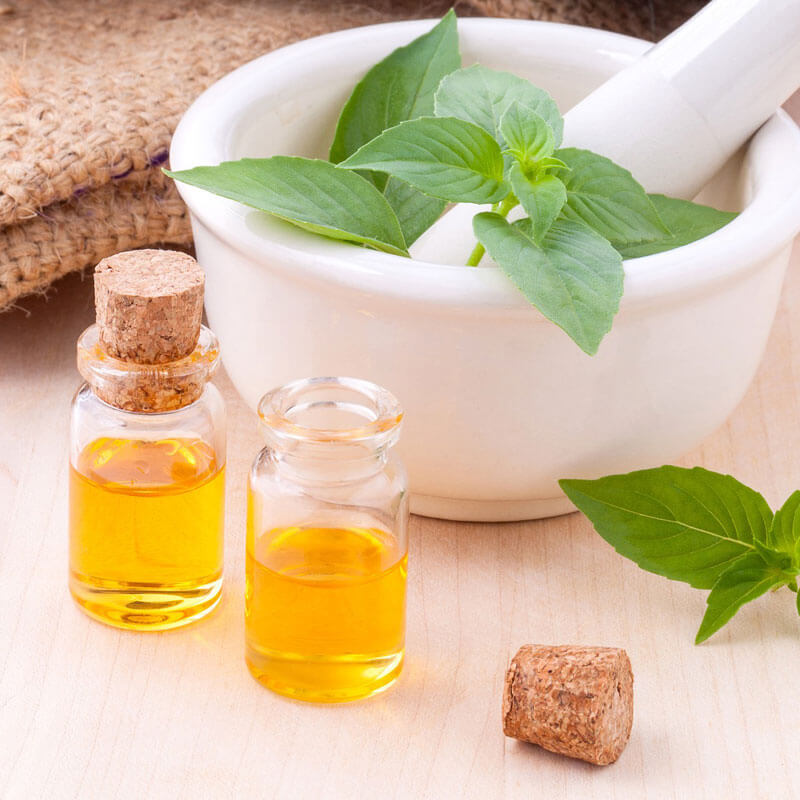Tarragon essential oil health benefits come from its rich estragole content. There is some controversy to using it, so be careful before diving in.
Table of Contents
Tarragon’s Plant Profile
As a member of one of the largest flowering plant families, Asteraceae, tarragon is one of around 500 varieties of the species Artemisia. Native to Europe and Asia but thriving in North America, as well, tarragon spans traditional uses as well as modern essential oil isolation. (1)
Tarragon grows in an upright, shrub-like formation with narrow leaves and bright yellow flowers. Much like modern use, traditional preparations of tarragon varied from culinary ingestion to medicinal extracts and preparations. (2)
As one of the main herbs in French cooking, tarragon leaves are flavorful and fragrant. The compounds in them are understood to act as an herbal “bitter,” stimulating the digestive system to better process food. This can have many implications, some of which translate into the essential oil compounds.
Top 4 Tarragon Essential Oil Benefits
Think of a fragrant dish simmering on the stove or baking in the oven – which culinary herbs and spices are you smelling? These are often full of aromatic compounds, the essential oils escaping and making your stomach growl. Tarragon is one such culinary herb with an essential oil element. If you haven’t tried tarragon essential oil yet, here’s what you need to know.
1. Antibacterial Food Safety
Often overlooked in antibacterial uses, one group of researchers took the opportunity to test tarragon essential oil’s bacteria-fighting ability and test it in real-life application. The study, released in 2012, not only tested tarragon for its chemical properties and effects in the lab (which many studies on many products do) but also tested it in a food preservation environment.
The results told us what we already know traditionally about essential oils: they are enhancers. Tarragon was effective against E. coli and Staph. aureus, and was even effective in protecting cheese during the study. Confirming both aromatherapeutic traditions of blending and tarragon’s contributions to food safety, they concluded:
Thus, it is suggested that tarragon EO be used as a part of a combination with other preservation…and can be applied as a natural preservative in food such as cheese. (3)
In both estragole-safety and effectiveness perspectives, tarragon included as part of the overall recipe can be beneficial, enjoyable, and safe in most cases.
Application: One to two drops blended into a lipid and added to culinary preparations, especially in combination with other culinary essential oils; cleaning blends for antibacterial surface protection.
2. Digestive Wellness
Tarragon as a whole herb carries many traditional uses for digestive wellness, from antidiabetic effects to lipid metabolism to liver protection and ulcer resistance. (4)
The whole herb is still likely the best inclusion for maximum digestive stimulation, but there are some important secondary effects that the essential oil has on digestive wellness, as well. Both topical and moderate internal use can yield big benefits with tarragon essential oil.
Translating those benefits to the essential oil isn’t necessarily direct – many of the studies have centered around water infusions and alcohol extracts. As you begin to experiment with tarragon as a culinary herb, you can utilize a drop or two of the essential oil now and then, as well. Consider inhalation and topical belly massages, as well, to introduce digestive wellness compounds in other ways.
Application: Use of the whole herb; some inclusion of careful internal use; blends for topical massage or inhalation.
3. Pain Relief
Often hand in hand with gastrointestinal wellness is the relief of gastrointestinal pain, and tarragon was used to relieve both concerns traditionally. A 2013 in vitro trial used an animal model to see just how tarragon essential oil might work to relieve painful conditions.
Pain relief was confirmed, validating yet another traditional use of an herb and its essential oil. (5) While the study wasn’t in humans or their typical applications, the effects remain and tarragon essential oil can reasonably be applied following safety guidelines to enhance blends intended to relieve discomfort.
Application: Massage oil blends, topical stomachache blends.
4. Anti-Inflammatory Swelling Reduction
The major compounds anethole and estragole found in digestive herbs like tarragon, anise, and fennel might have some controversy surrounding them, but they also carry benefits. One group of researchers evaluated the effects of anethole and estragole on swollen paws of mice. Not only did the treatment relieve the swelling, but there weren’t any signs of toxicity. (6)
This doesn’t tell us to throw caution to the wind, but it does demonstrate a couple of important things about tarragon and the other digestive herbs and essential oils. First, pain relief and gastrointestinal benefits are likely tied to anti-inflammatory actions. And second, toxicity in many cases depends on use. Be smart with your oils and stay safe.
Application: Massage oil and other topical blends, especially for swelling, sore muscles, and inflammatory illness.
Estragole’s Controversial Twist
Before we get into the ways you can use tarragon essential oil, it’s important to know what you cannot do. One of the main components of the essential oil content in tarragon is called estragole, which can also be indicated as methyl chavicol, among other names. (7)
Reviewing similar cautions for fennel essential oil, you’ll find that many whole herbs known for their digestive prowess also have concentrated estragole in their essential oils. The complexities of nature are so intriguing!
The bottom line for estragole safety is to use your essential oil in absolute moderation and wisdom. Ask your supplier for a copy of the GC/MS evaluation to know how much estragole is in that batch of tarragon, and only use it internally if the percentage is low and the dilution high. In preparations, one or two drops for an entire meal is more than enough to suffice.
Official safety statements for estragole confirm that moderation is key – toxicity levels were far above anything we’d actually consume – however, a few demographics should minimize use (8):
- Pregnant or nursing women,
- Children, and
- Individuals with seizure disorders.
With that said, tarragon has stood the test of time, and it seems the essential oil will, as well. Here are some of the reason’s tarragon (used safely) isn’t going away.
How to Use Tarragon Essential Oil
As more research is conducted, we will undoubtedly learn details that will improve our use. Learning how essential oils like tarragon work in the body, why estragole is concentrated in digestive herbs yet not without its controversial effects, and the best ways to get the most out of an oil will come to light bit by bit, study by study. For now, we can mimic traditional wisdom in light of what we do know. Some suggested tarragon uses include:
- Stomachache topical blend, including oils like lavender
- Culinary essential oil use, with one or two drops per recipe.
- Topical treatments for antioxidant skin health
- Massage oil inclusion for easing tense, painful muscles
- Whole-herb use, taking advantage of the entire composition of tarragon to mitigate estragole and allow for fewer safety concerns
- http://www.academicjournals.org/article/article1390551311_Tak%20et%20al.pdf
- http://link.springer.com/article/10.1007/s11094-008-0064-3
- http://www.ncbi.nlm.nih.gov/pmc/articles/PMC3391558/
- http://discovery.ucl.ac.uk/1352036/
- http://www.ncbi.nlm.nih.gov/pubmed/24074293
- http://www.if-pan.krakow.pl/pjp/pdf/2012/4_984.pdf
- http://webbook.nist.gov/cgi/cbook.cgi?ID=C140670&Mask=4&Type=ANTOINE&Plot=on
- http://www.ema.europa.eu/docs/en_GB/document_library/Scientific_guideline/2010/04/WC500089960.pdf







